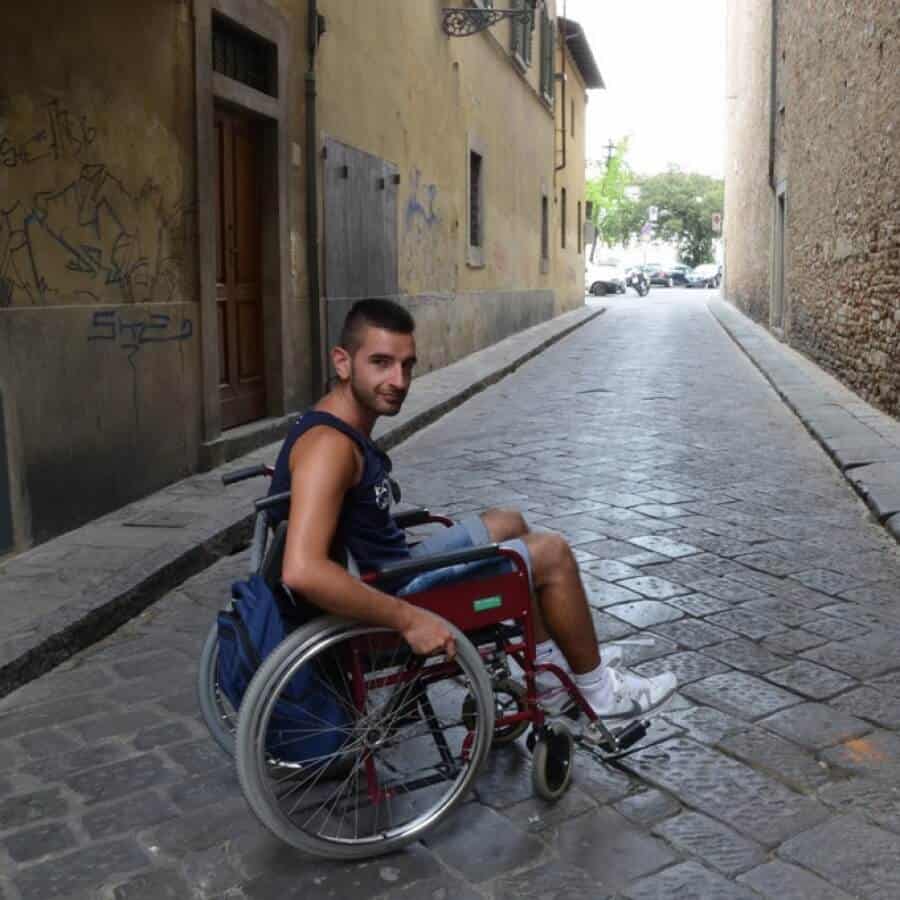Imagine life with no steps. No running. No dancing. Imagine shouting words that nobody hears or eyes that look but are not being looked at. This feeling of resentment and weakness, as well as striving to help, has made Bogdan Stevanovic (28) – also known as Blogdan – sit in a wheelchair and spend eight days as a disabled person in the middle of Florence trying to experience all the obstacles disabled people face on an everyday basis. This project was part of his Master’s Thesis, and he talked more about it at this year’s TEDx Zemun event, held in Belgrade. After the project was over, the city of Florence took the first steps to make more places accessible to people in wheelchairs, but Bogdan says the rest of Europe needs to wake up, too. Instead of feeling sorry, this is what he did.
Meet Bogdan Stevanovic
Bogdan, you are one of the most read bloggers in the ex-Yu region, but you actually hold a Master’s Degree in tourism. What made you study tourism instead of journalism or literature? Did writing come along later on, as a way of expressing yourself in a different way?
Actually my Bachelor’s Degree is in tourism, and my Master’s Degree is in travel journalism. But anyway, your question is on point. What made me study tourism instead of journalism is the fact that in that precise moment when one must decide what to study, the average individual is still too young to know himself completely. So, I later tried to fix a mistake from my first four years of study by merging my two passions for traveling and writing, and that’s travel journalism.
What you did as part of your Master’s thesis inspired the TEDx Zemun team in Belgrade, led by Milica Radovic, to invite you to be one of the speakers at this year’s conference. How much, in your opinion, can speeches like this actually make a change?
I know that speeches cannot make big changes. Only action. My speech is completely worthless if it doesn’t inspire someone to act. Therefore I’m very grateful first of all to Milica and then to you for the opportunity to spread this idea further through this interview as well, and to call for action by talking about the problems which people in wheelchairs are facing.

Can you tell us briefly what was the initial idea behind your project?
The initial idea was to explore and investigate one city from the point of view of a person in a wheelchair, and to deal with all the inevitable obstacles in order to understand them better and experience them first-hand so we can suggest solutions.
What gave you the inspiration to try to change the situation of people disabled in this way?
I am bored with projects that have only one purpose – generating money – and find them meaningless. For me, it must be something with a higher purpose. So I was thinking about what could that be. And the idea came to me very easily and clearly.
Your eight-day experiment was held in the city of Florence. Is there any specific reason you picked Italy for your research?
The truth is that we didn’t pick the destination, it was assigned to us. This project was organized something like a lottery, and each group needed to pick an envelope with an unknown destination. After opening our envelope, we realized it was Florence. In other envelopes were Sicily, Morocco, Scotland, and Shanghai.
You spent eight days with five other people living the life of a disabled person touring around Florence in a wheelchair. What kind of institutions did you visit, and what were the least adaptable ones?
We visited all the museums and galleries, every square, most of the churches and cathedrals, almost every hotel, hostel, and a lot of restaurants. As well as all the main pharmacies, cash exchange offices, public toilets, train and bus stations, and some bars and night clubs. We used public transport, too.
Florence is a medieval city, and the Old Town (city center) is under UNESCO protection. It is forbidden and in some cases impossible to adapt buildings, churches, and pavements.
That was the reason why it was so challenging to explore this particular city. Giotto’s bell tower is completely inaccessible, and for example, Dante’s museum is accessible, but the last floor where you can see the real manuscript of his Divine comedy is not accessible for people in wheelchairs.
This experiment opened the doors of a whole new world for you and the colleagues in your group. Now that you know what it is like being just a bit different, what do you think these people face the most in everyday life?
Even though I decided to talk about this issue and I know how it feels to move around in a wheelchair, I must say I do not know everything, and that I don’t want to speak in the name of disabled people, I want to speak about them and their problems. They are not faced only with architectural barriers but with discrimination on a daily level, which is more challenging.
Was there any surprisingly positive or negative reaction from people? Did you have any specific problem you had to deal with, or did you encounter unexpected help and positive attitudes?
Official reactions were mostly good, but the question is what provokes those reactions. Is it compassion or fear, pity . . . I think there is a big job to be done on understanding what are the basic needs and rights of all disabled people and minorities in general.

During the experiment, you even created two applications that can help. Can you tell us more about this, and are they widely used today?
Unfortunately not. To maintain an app, you need money. To publish a tourist guide, too. We didn’t have it. So, basically, this project was finished and left in a drawer. I am willing to admit it was our fault, but in a capitalistic world, it is very difficult to fight for anything without strong backing to start.
At the end of the experiment, the city of Florence made some changes. What were those, and what local institutions were ready to give support?
When we were there, there was only one taxi accessible for people in wheelchairs in the whole city of Florence. Today, there are five. As well, the tourism office of the city of Florence made some architectural changes after our project, and now, the office itself is completely accessible to all tourists. Those are some small but very important steps.
As an indication of support from local institutions, we also received a few e-mails where they expressed their gratitude and wished us all the best. The local tourist organization provided us all the information they had, gave us some advice, and most importantly – they gave us city maps to use and published them completely for free. That was a very generous gesture.
Is it possible to make a bigger impact on authorities around Europe to improve the position of these people, and how?
I’m sure it is. Especially nowadays as mass tourism slowly starts to modify itself into something more responsible. That’s why we have eco-tourism, rural tourism, green tourism, ethical tourism, so I strongly believe that by talking about this challenging topic things will get better.
What would be your message to all the young people in wheelchairs who struggle with challenges every single day?
To stay strong, loud, and visible as much as they can. It is easier to be said than to be done, but this world can be changed only by action, so I’m willing to take my first step with this project, to pull it out of the drawer and make something useful of it.
Discover the blog of Bogdan Stevanovic and get closer to the best stories on Balkan. More about similar topics, you can read here.
Photo credits: Carla Llamas Peña
Support us!
All your donations will be used to pay the magazine’s journalists and to support the ongoing costs of maintaining the site.
Share this post
Interested in co-operating with us?
We are open to co-operation from writers and businesses alike. You can reach us on our email at [email protected]/[email protected] and we will get back to you as quick as we can.










